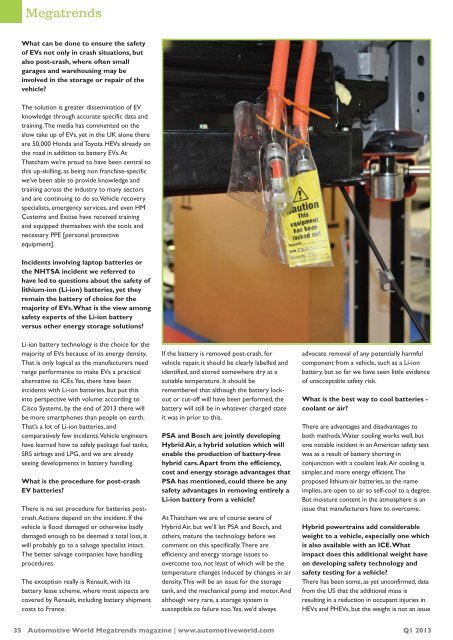megatrends
megatrends
megatrends
Create successful ePaper yourself
Turn your PDF publications into a flip-book with our unique Google optimized e-Paper software.
Megatrends<br />
What can be done to ensure the safety<br />
of EVs not only in crash situations, but<br />
also post-crash, where often small<br />
garages and warehousing may be<br />
involved in the storage or repair of the<br />
vehicle?<br />
The solution is greater dissemination of EV<br />
knowledge through accurate specific data and<br />
training. The media has commented on the<br />
slow take up of EVs, yet in the UK alone there<br />
are 50,000 Honda and Toyota HEVs already on<br />
the road in addition to battery EVs. At<br />
Thatcham we’re proud to have been central to<br />
this up-skilling, as being non franchise-specific<br />
we’ve been able to provide knowledge and<br />
training across the industry to many sectors<br />
and are continuing to do so. Vehicle recovery<br />
specialists, emergency services, and even HM<br />
Customs and Excise have received training<br />
and equipped themselves with the tools and<br />
necessary PPE [personal protective<br />
equipment].<br />
Incidents involving laptop batteries or<br />
the NHTSA incident we referred to<br />
have led to questions about the safety of<br />
lithium-ion (Li-ion) batteries, yet they<br />
remain the battery of choice for the<br />
majority of EVs. What is the view among<br />
safety experts of the Li-ion battery<br />
versus other energy storage solutions?<br />
Li-ion battery technology is the choice for the<br />
majority of EVs because of its energy density.<br />
That is only logical as the manufacturers need<br />
range performance to make EVs a practical<br />
alternative to ICEs. Yes, there have been<br />
incidents with Li-ion batteries, but put this<br />
into perspective with volume: according to<br />
Cisco Systems, by the end of 2013 there will<br />
be more smartphones than people on earth.<br />
That’s a lot of Li-ion batteries, and<br />
comparatively few incidents. Vehicle engineers<br />
have learned how to safely package fuel tanks,<br />
SRS airbags and LPG, and we are already<br />
seeing developments in battery handling.<br />
What is the procedure for post-crash<br />
EV batteries?<br />
There is no set procedure for batteries postcrash.<br />
Actions depend on the incident. If the<br />
vehicle is flood damaged or otherwise badly<br />
damaged enough to be deemed a total loss, it<br />
will probably go to a salvage specialist intact.<br />
The better salvage companies have handling<br />
procedures.<br />
The exception really is Renault, with its<br />
battery lease scheme, where most aspects are<br />
covered by Renault, including battery shipment<br />
costs to France.<br />
If the battery is removed post-crash, for<br />
vehicle repair, it should be clearly labelled and<br />
identified, and stored somewhere dry at a<br />
suitable temperature. It should be<br />
remembered that although the battery lockout<br />
or cut-off will have been performed, the<br />
battery will still be in whatever charged state<br />
it was in prior to this.<br />
PSA and Bosch are jointly developing<br />
Hybrid Air, a hybrid solution which will<br />
enable the production of battery-free<br />
hybrid cars. Apart from the efficiency,<br />
cost and energy storage advantages that<br />
PSA has mentioned, could there be any<br />
safety advantages in removing entirely a<br />
Li-ion battery from a vehicle?<br />
At Thatcham we are of course aware of<br />
Hybrid Air, but we’ll let PSA and Bosch, and<br />
others, mature the technology before we<br />
comment on this specifically. There are<br />
efficiency and energy storage issues to<br />
overcome too, not least of which will be the<br />
temperature changes induced by changes in air<br />
density. This will be an issue for the storage<br />
tank, and the mechanical pump and motor. And<br />
although very rare, a storage system is<br />
susceptible to failure too. Yes, we’d always<br />
advocate removal of any potentially harmful<br />
component from a vehicle, such as a Li-ion<br />
battery, but so far we have seen little evidence<br />
of unacceptable safety risk.<br />
What is the best way to cool batteries -<br />
coolant or air?<br />
There are advantages and disadvantages to<br />
both methods. Water cooling works well, but<br />
one notable incident in an American safety test<br />
was as a result of battery shorting in<br />
conjunction with a coolant leak. Air cooling is<br />
simpler, and more energy efficient. The<br />
proposed lithium-air batteries, as the name<br />
implies, are open to air so self-cool to a degree.<br />
But moisture content in the atmosphere is an<br />
issue that manufacturers have to overcome.<br />
Hybrid powertrains add considerable<br />
weight to a vehicle, especially one which<br />
is also available with an ICE. What<br />
impact does this additional weight have<br />
on developing safety technology and<br />
safety testing for a vehicle?<br />
There has been some, as yet unconfirmed, data<br />
from the US that the additional mass is<br />
resulting in a reduction in occupant injuries in<br />
HEVs and PHEVs, but the weight is not an issue<br />
35 Automotive World Megatrends magazine | www.automotiveworld.com Q1 2013


